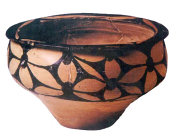Yangshao Culture Yangshao Culture occurred in the late period of Neolithic Age (about 4,950 to 6,950 years ago). It was first discovered in Yangshao village of Mianchi City, Henan Province, hence the name. | 
|
Yangshao Culture saw the flourish of pottery making. At that time, pottery workshops were distributed along the banks of the Yellow River, centering on Henan Province and the Central Plain of Shaanxi Province. All the pottery objects of this period appeared in red color, because the local clay of which they were made contained a high percentage of ferrous compounds that turned red after oxidation under high temperature. Hence, Yangshao Culture is often referred to as Painted Pottery Culture. The most striking piece is a basin with a design of human face and fish out of Banpo village in the neighborhood of Xi'an, Shaanxi Province. On the other hand, Yangshao Culture marks a great leap forward in construction. Primitive villages were found in a neat and orderly arrangement on the site of Jiangzhai at Lingtong County, Shaanxi Province. In the center of the living quarter is a large open ground. Buildings are scattered around it in five groups. In the middle of each group stands a big house with ten or a score of houses arranged nearby. Two big moats, two meters (6.56 feet) or so both in width and depth, envelope the whole area as ancient defensive works. Outside of the moats, there discovered three graveyards and about 170 adult tombs. Children's burial jars were found close to houses.
During the days of Yangshao Culture, the primitive society culminated in tribal clan community. From the objects unearthed from tombs, a large amount of narrative or documentary pictures were carved inside of pottery jars or on the lids, including designs and figures of human, tortoise, bird and deer. They provide precious sources for the study of prehistoric mythology. Moreover, the remains of ancient hampered-earth city walls have been found in Xishan, Henan Province. |